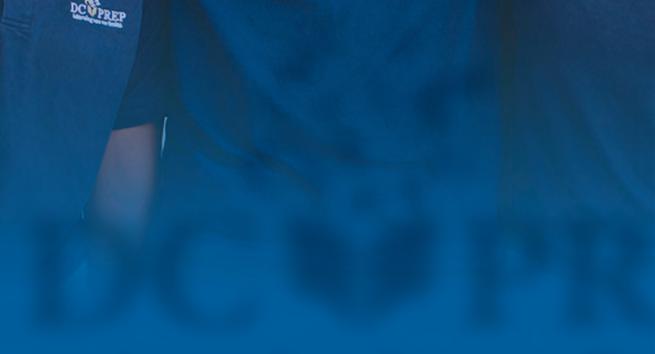














Elizabeth O’Gorek
Elizabeth O’Gorek
E.V. Downey






















Elizabeth O’Gorek
Elizabeth O’Gorek
E.V. Downey






by Elizabeth O’Gorek
Imeet “Alicia W.” on a weekday at around 4 p.m. She is sitting at a computer in the Arthur Capper Recreation Center Tech Express, the temporary facility open since the Southeast library closed. Initially, she is hesitant to talk to me—her homework is due every week on Friday and the library closes at 6 p.m. At her middle school, there’s a laptop that’s “hers,” but she can’t bring it home.
There’s internet at her house, “but it kind of sucks,” she tells me. Technically Alicia has a device—an older iPhone. But she is writing long essays and reports and formatting images in text. “how am I supposed to do this on a phone?” she says, gesturing to the geography report on her screen.
Most weeks, she gets her Friday assignments done —but there are days that Capper is packed or she has to go home to care for her younger siblings, meaning she can’t get the homework done.
“They get pissed,” Alicia said of teacher reaction when she has nothing to submit, “and tell me to figure it out, get it done, it’s important.”
Digital equity in District Schools was at the forefront of the news in 2020, as schools switched to online learning in the wake of the COVID-19 pandemic. In 2020 a partnership of National Education nonprofits found that DC had the second highest gap nationally for high-speed internet access between White and Black students.
A 2023 Office of the Chief Technology Officer (OCTO) survey found while the numbers have improved somewhat overall, the gap persists. While District residents overall have access to high speed
internet, it is Black, Hispanic and lower-income families that have less access to connected devices, broadband and digital literacy than their White neighbors.
How have stakeholders through the District worked to improve access to devices, broadband internet and digital literacy in public and public charter schools since 2020? What are challenges and next steps?
In 2020, the District estimated that 30 percent, or 26,650 of District students needed a device, with the greatest need in minority and low-income families, particularly those living in Wards 5, 7 and 8.
Data on the current state of student digital access is scant and less comprehensive. In 2022, the OCTO established the State Broadband and Digital Equity Office (SBDE, www.techtogetherdc.com) to support the District’s digital equity initiatives enshrined in law that same year. A 2023 SBDE survey found only 67 percent of residents in DC have enough access to internet-connected computers, laptops, or tablets at home to meet their household’s needs.

school parents came together to advocate for technology in the schools and called for DCPS to provide a device for every child. Founders say that meant by the time the pandemic hit they had already placed an initial order for technology.
In 2020, the city also launched the Empowered Learners Initiative (ELI), a plan designed to move the District to a 1-to-1 device ratio for students over a three year period. By 2022, DC claimed success, having modified that requirement to only apply to students in grades 3 or older and a 3-1 student to device ratio in the grades below.
But Digital Equity in DC Eduction (www.digitalequitydced.com)
The work to close that gap is ongoing and started long before the pandemic. Digital Equity in DC Education was formed in 2018 when three public
Co-Founder Grace Hu cautions against resting on our laurels. Technology obtained in 2020 has aged quickly. The DCPS technology plan recommends replacing devices every four years. That’s an expensive prospect, and one that DCPS has shown reluctance to fund, she said. When DC Council cut $25 million from the 2025 DCPS Central Office budget, the system responded by reclaiming amounts from technology, putting off replacement of obsolete machines. And since the pandemic, many schools do not permit students to take devices home without special permission, meaning that kids like Alicia


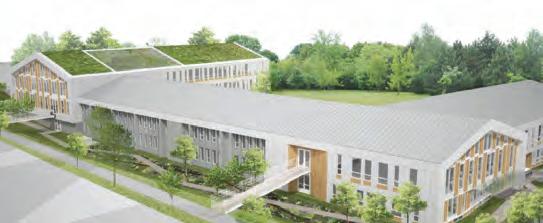
Apply for admissions at: www.myschooldc.org or call (202) 888-6336
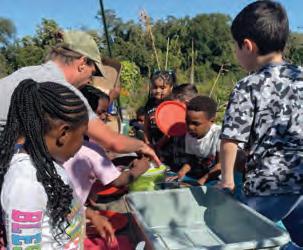
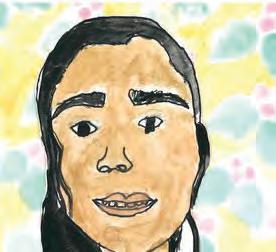
Join us for building tours & information sessions to learn more about our programs: For questions, contact our enrollment team: Call (202) 545-0515 or email enrollment@bridgespcs.org SCAN THIS QR
Wed. Jan, 22
9:30 AM - 10:30 AM Sat. Feb, 1 9:30 AM - 10:30 AM Tues. Feb, 4
5:30 PM - 6:30 PM Wed. Feb, 19
9:30 AM - 10:30 AM






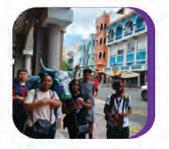
MMBDA’s Dual Immersion Program follows the 50:50 Two Way Dual Immersion model for students in PreK3 through Grade 5. In this model, students spend 50% of their instructional time in English and 50% of their instructional time in Spanish.



10:1 Student to Teacher Ratio
50/50 Spanish Language Immersion Program for Early Childhood and Elementary students Free School Bus Transportation
Robust Academic and Afterschool Programs
S.T.E.A.M. Program including Coding and Robotics


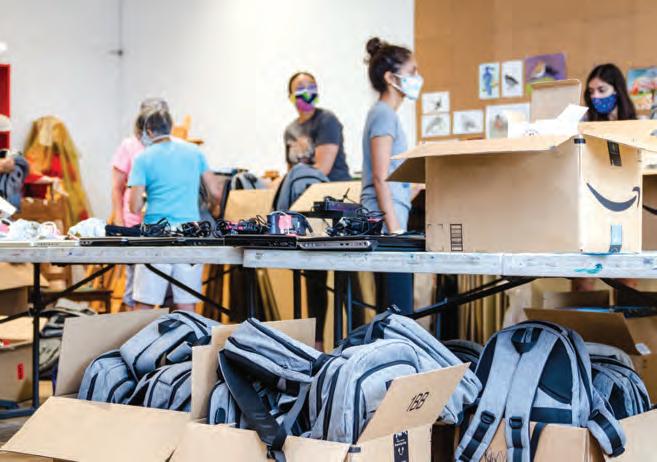
“...COVID is over,” she said. “They’re not giving us any help [with school] at home now.”
still struggle to complete homework online.
There are ways to access computers out of school. Like Alicia, kids have access to public computers at DPR lounges and DC Public Libraries (DCPL), the latter of which has 1,000 computers in 26 libraries. Some of the charter schools have leaned into technology and still hand out laptops for students to use at home. At KIPP DC, students can apply for a laptop and hotspot. There’s even tech support to families via a website and dedicated telephone number.
The gap in tech at home has also been filled by nonprofit groups. Acting as the hub for Ward 6 Mutual Aid, Serve Your City DC hands out backpacks containing laptops and tablets along with other school supplies during its annual back-to-school drive, handing out 7,000 since 2020. Serve Your
City also founded a Digital Devices Training Program, which gives Black and Brown youth in DC hands-on experience in acquiring, refurbishing and distributing digital devices where they live, also teaching them to provide tech support to families and neighbors.
Tech corporations have stepped into the breach as well. In July and August 2024, AT&T distributed laptops and backpacks to 200 students at the Boys & Girls Club (4101 Benning Rd. NE). Nadia Pedersen, Senior Regional Director of Operations for the Boys & Girls Clubs of Greater Washington said that the laptops “will make a profound difference in the lives of our kids, especially those who do not have access to a computer at home.”


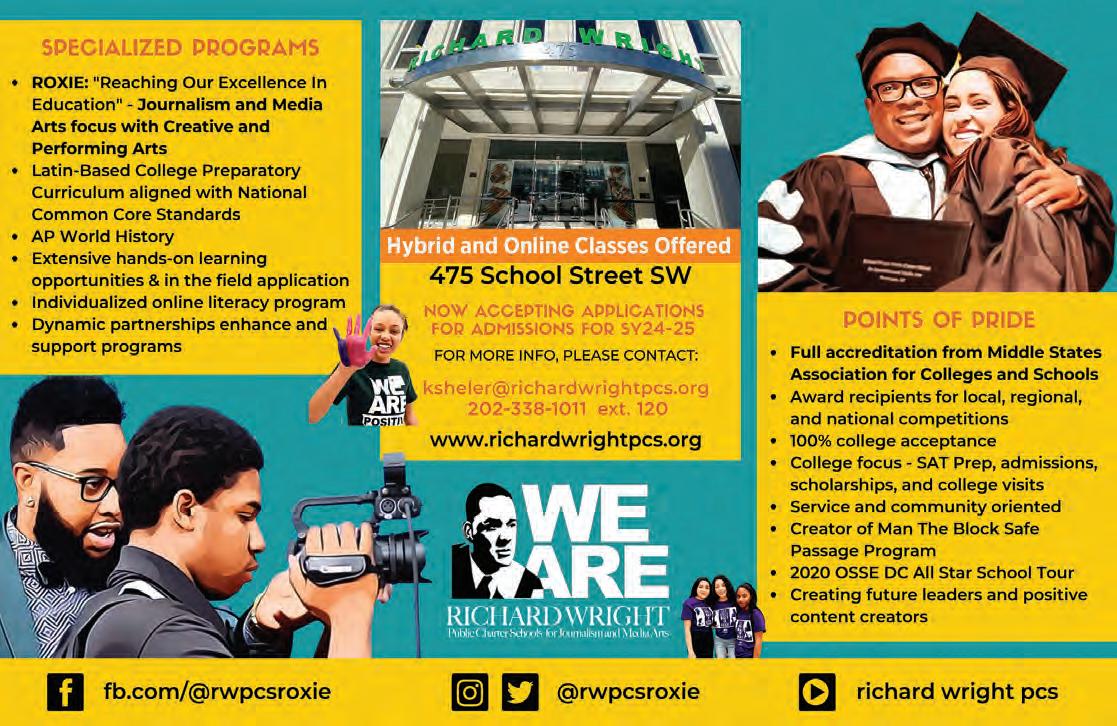






terac Tech Summer Camp is speci cally designed to provide DCPS students in Wards 5, 6, 7, and 8 with a ve-week digital literacy summer camp.


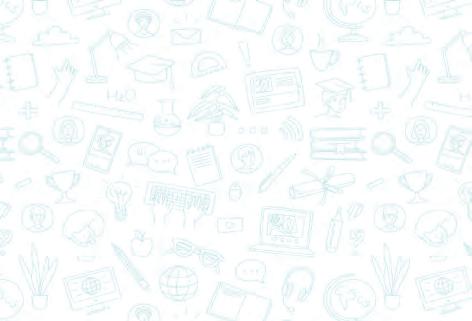
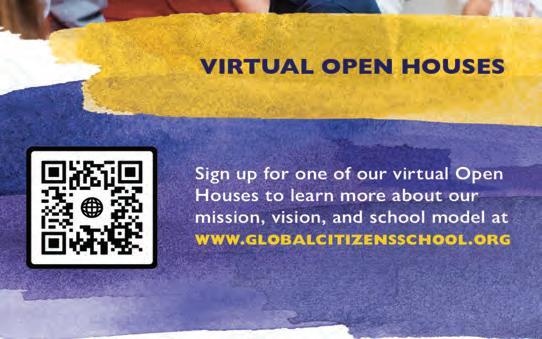

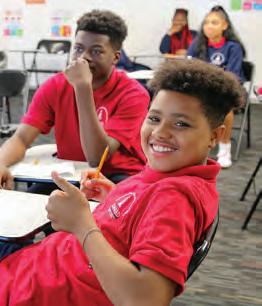
a school supply as a pencil, students must know how to use them to nd, analyze and communicate information e ectively. at skill is digital literacy and it is increasingly emphasized as knowledge that is critical to success in school and future employability. Access to digital literacy is mixed. OCTO o ers computer training and digital literacy classes called Tech 101, but these are focused on seniors and adults. Similarly, 4,132 people attended DCPL digital literacy trainings in Fiscal Year 2023 alone. Classes range from computer basics to Microsoft certi cations. But these are also often geared towards adults or seniors. Some schools extend digital literacy training beyond students and into their homes. At Capitol City Charter, the Middle School Digital Literacy teacher works with the library team to teach research skills, technology, and to develop strong digital learners. Last March, ten parents and other caregivers nished the Family Computer Literacy Program, attending classes Monday and Tuesday nights throughout the month to learn how to use email, adjust settings and use the school’s communication programs. On the nal day of the course, they received a certi cate and their own Chromebook. “ e hope is that providing a laptop and technological knowledge to the community helps close the digital divide that prevents some from using technology,” said the Family Engagement Team. Mr. McCullough, the MS Instructional Technology Coordinator, said the digital divide was preventing families from accessing opportunity. “I wanted to be part of helping to ght against that inequity.”

Nonpro t Tech Turn Up works with public schools to o er Digital Citizens, a course for middle and high school students. ey learn about digital technology, internet navigation, online communication and concerns about safety and privacy, o ering the course in partnership during the school day and as part of after care. eir In-
Devices and the ability to use them still require an internet connection. During the pandemic, schools quickly moved to provide WIFI access and hotspots for free. But student home internet access was often facilitated by the city using COVID funds, such as the federal Internet for All initiative, which ended when COVID funding ran out.
In 2023-24, SBDE estimated that between 120-130,000 DC residents did not have Internet in their homes; about 88,000 do not have broadband subscriptions.
Many cited cost as a barrier. In 2020, a study of American cities found that DC had the highest standard nonpromotional internet pricing, between $70 and $88 in monthly fees.
In 2021, the federal government created what would become the A ordable Connectivity Program (ACP). e program provided internet access for low-income families that bene ted from federal assistance programs, such as Supplemental Nutrition Assistance Program (SNAP) or Medicaid. But Congress ended funding for the program as of June 2024.
It’s not yet clear how that has impacted District families, or how many are aware of the program’s ending, the Federal Communications Commission (FCC) warned. About 105,000 DC houses quali ed for the program; half of these (53,000) were enrolled. DC OCTO estimates that for about 12 percent of District household’s even a $30/month internet plan is a strain on the monthly budget; the 2023 survey by SBDE found that 51 percent of respondents said they had di culty tting the internet bill into their monthly budgets.





AFTER-SCHOOL PROGRAMS: Engaging and enriching programs with a focus on STEM, CTE, and social justice topics.
CONVENIENT LOCATION: Just 2 blocks from Ft. Totten Metro, making accessibility easy for families.
CREW: Every child belongs to a tight-knit family known as their CREW—like homeroom, but better.
EXPEDITIONARY LEARNING: Students explore real-world issues, read texts, and study social justice topics that matter to them.
LIBERATORY DESIGN THINKING: Hands-on, research-based problem-solving to tackle community challenges.
The Social Justice School catalyzes an integrated community of middle school students to become ScholarActivists dedicated to designing a more just
SOCIAL JUSTICE: Graduates lead or participate actively in campaigns to shape the future.

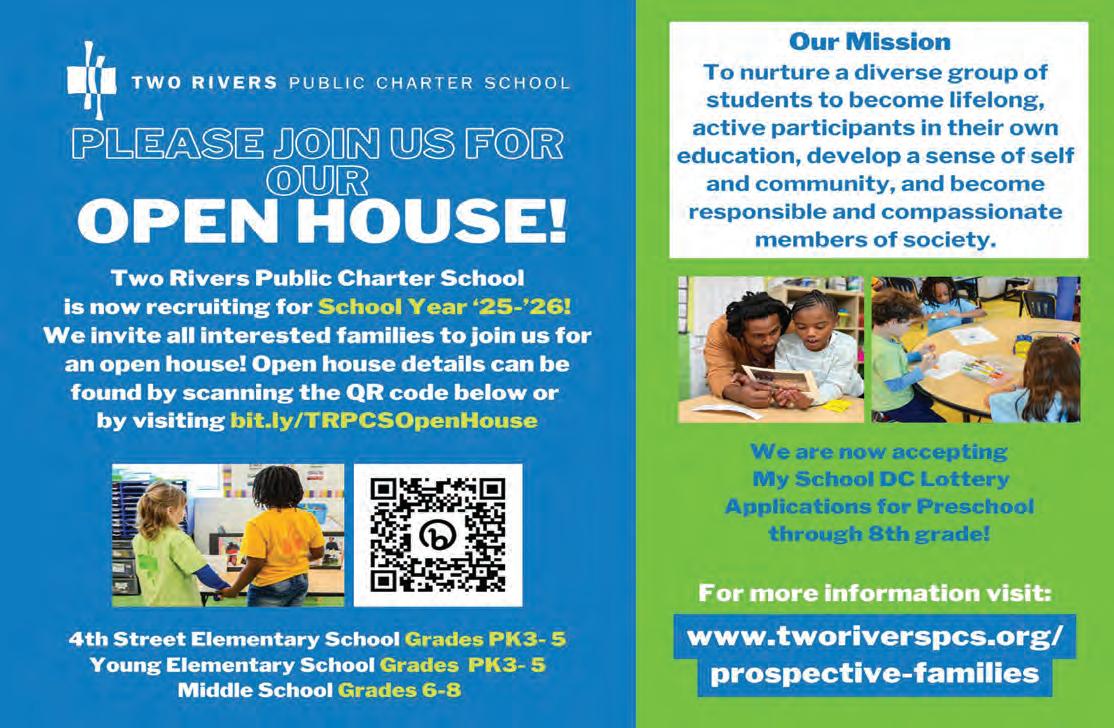
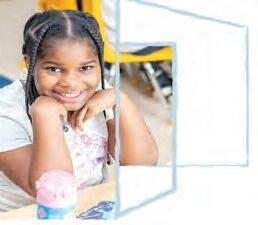




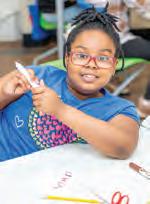
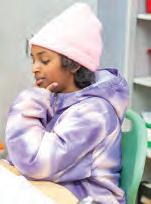


a ordable internet plans for qualifying households. Families with nancial need can apply for Comcast’s X nity Internet Essentials, a low-cost, high-speed internet plan. And RCN’s Astound Broadband o ers data limited plans for $15 and $20 a month.
DC has expanded high speed internet access. DC-Net provides free wi- access from public buildings such as schools, libraries, recreation and senior centers and a total of 700 public hotspots in the District. OCTO established the Community Internet Program, allowing internet providers to install service antennas for free on DC-owned buildings in exchange for providing high speed internet to residents of those buildings for free or low cost. OCTO provided free internet access at two public housing complexes, Hopkins Apartments (1000 12th St. SE) and Potomac Gardens (700 12th St. SE).
DC’s SBDE has vowed to deliver connectivity, expand device access and create more equitable opportunities to tech skills and education, creating a State Digital Equity Plan (SDEP) in 2023. It is literally the Number 1 goal of the SDEP to achieve universal availability of 100/20 Mbps internet in DC households, especially among covered populations, to get them devices and digital skills. ose e orts could expand.
DC has won two grants in the last year that should go a long way towards helping to achieve these goals. In May, the federal National Telecommunications and Information Administration (NTIA) awarded the District $100.6 million in federal funds through the Volume II Initial Proposal under the Broadband Equity, Access, and Deployment (BEAD) Program. OCTO has said they will use the funding to make a ordable high-speed internet accessible to all, to provide low or nocost devices to the residents who need them and provide digital literacy and
skills training. In December, NTIA awarded another $3.8 million in Digital Equity Capacity grants. OCTO says they will use these funds to help implement the digital equity plan, which emphasizes access to devices and digital training.
But how this will impact schools is not explicitly named in the 2023 plans, so it is unclear how —or if—the funding will speci cally target the digital divide among the District’s students.
Some advocates familiar with the equity plan and the grants are waiting to see. Digital Equity in DC Education’s Hu said this is an opportunity to establish equitable infrastructure for the long term. “But, after the federal money dries up, you have to have a plan to sustain investment,” and, adds co-founder Melody Molino , so far advocates have not seen any such indication.
Hearing about the hundreds of millions of grants as she sits in front of the computer at Arthur Capper, Alicia is also skeptical any of it will go to help her get her homework done. “It feels like, COVID is over,” she said. “ ey not giving us any help [with school] at home now.”
Learn more about O ce of the Chief Technology O cer (OCTO), the State Broadband and Digital Equity O ce and District-wide technology plans at www.techtogetherdc. com. See the DCPS Technology Plan at lims.dccouncil.gov/Legislation/ RC25-0038. ◆


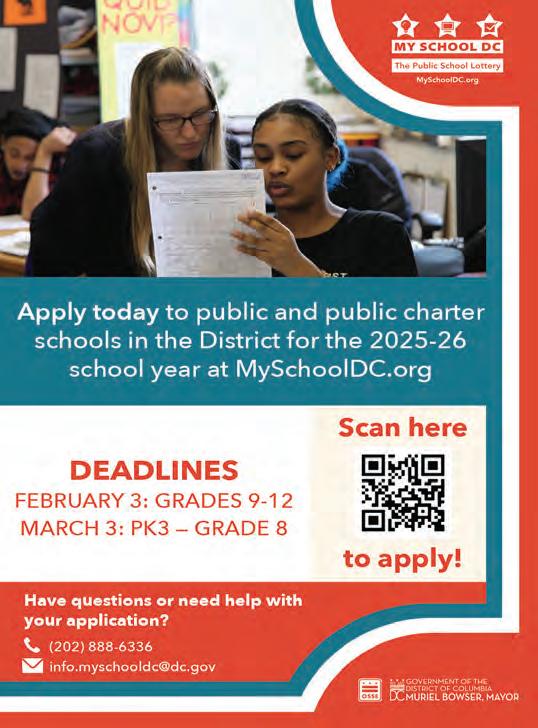


















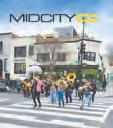
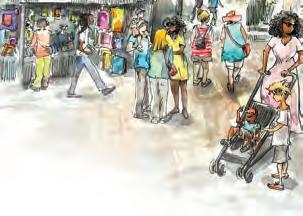

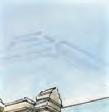
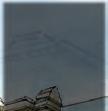

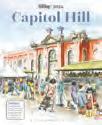

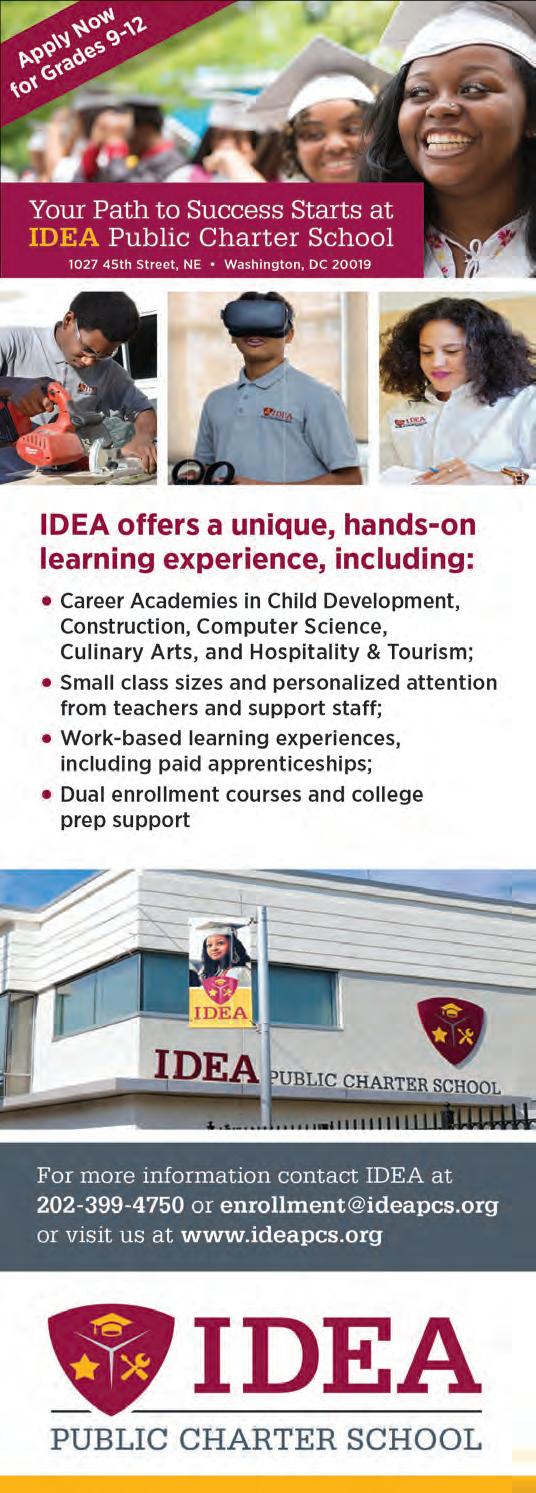

by Elizabeth O’Gorek
Lucy and her spouse are in their late thirties with two kids aged 6 and 8. She says they’re just starting to plan for the children’s college education. Both have professional degrees and are homeowners also saving for their own retirement.
But at the same time, Lucy and her husband still have their own outstanding student loans, more than $100,000 dollars between the two of them. The couple is sitting down in January to consider whether it would be best to put money towards retirement, savings or future tuition.
“College is crazy expensive and I think it’s only likely to get worse,” Lucy said. “But sometimes I wonder if we’re going to pay off our own loans before we write the first check for tuition.”
According to the Education Data Institution (educationdata.org) the average cost of in-state tuition alone is $9,750. District students have limited in-state colleges to choose from, and out-of-state tuition averages $27,457 rising to $38,270 with living expenses.
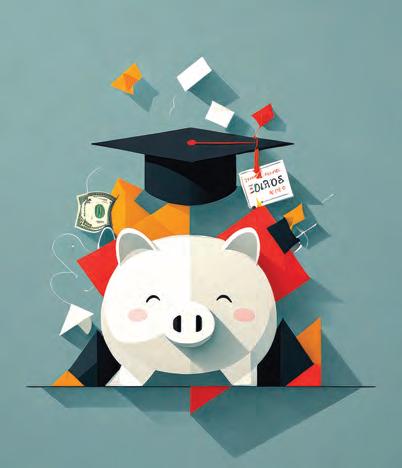
But if a student attends a private school, those fees can skyrocket. Tuition and fees at Georgetown University last year were $66,000; room, board and books another $21,000.
According to a 2024 study from education nonprofit College Board (collegeboard.org), less than half of parents had a plan to cover their child’s full education. At current tuition rates, saving enough to pay for four years of college may seem impossible to many. While 75 percent of parents have savings earmarked for the children’s education, the average savings was $45,000, only about enough to fully cover an average first year.
Given their own student loan situation and the effect it is having on all aspects of their lives, Lucy and her spouse say that the best gift they can give their children is a college degree that comes with as little debt as possible. With some planning, research and thought, they plan to find ways to finance their children’s college education without sacrificing their retirement savings and the family’s quality of life in the present.
Doing so will require learning about and using all the DC assistance programs, scholarships, money management skills and tax benefit programs available. Here are some considerations for parents and students as they look into planning—or paying—for college.
Aaron Smith is co-founder of Savi (www.bysavi.com), a
sort of Turbotax for student debt. Savi streamlines various creditors, finds ways to reduce amounts and then identifies the cheapest and quickest ways to pay the debt.
Smith says both students and parents can be very casual about student debt. “Keep in mind, this is, for many young people, the biggest financial decision they’ve ever had to make. You’re going from being a high school student to now taking on tens of thousands of dollars of debt. It’s not surprising that they don’t understand all the implications of that.”
$50,000 in student loan debt translates into about $1,000 a month in repayments, he estimated, a good chunk of a rent payment. “Too many parents and students don’t understand that basic math before they make the decision to take on debt,” Smith said.
Once the student is ready to apply to college, families should evaluate how much each college will cost and begin to create a list of affordable colleges given college savings, in-state, out-of-state tuition, and the student’s preferred colleges and likely major if they have one. The best way to avoid taking on too much student debt is to avoid applying to out-of-budget colleges in the first place. While there are many reasons a student may want to go to a particular college, studies have shown that, outside of attendance at Ivy League and a few other top schools, future income is not affected by which college you go to.
Tuition and fees are usually stated up front by the school, but don’t forget to factor in housing and meals and other additional education-related expenses such as books, software and transportation. “Once you know the cost of attendance, you can better plan how to cover your educational expenses,” the FSA advises.
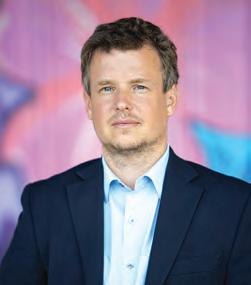
Before you borrow, Smith recommends a cost-benefit analysis of the schools and programs the student is considering versus the debt taken on to enter them. Can the graduate expect to earn enough to repay them successfully? At what cost to whose lifestyle and for how long? Which loan offers the best terms? Missing payments is about more than just money owed. Damage to either parent or student credit ratings affects future financial matters such as mortgage and credit applications.
Once costs have been determined, research possible sources of funding. There are a few federal and District programs that can help —and you won’t need to repay the money. Your Savings. “It’s a joke we tell,” said Zaina Bank-
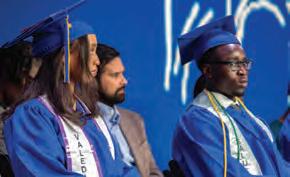
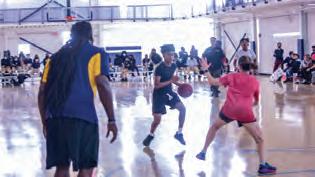
Apply today for School Year 2023-2024. Seats are limited. Complete the application online through MySchoolDC.org
#ChoosePaul and we’ll choose you back! Increase your chances of being matched with Paul PCS by making us your #1 selection


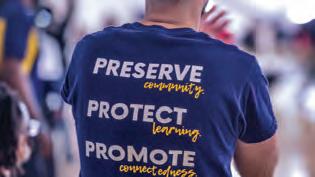

• Tier 1 High School and a 2022 Bold Performance School for the Middle School
• Guaranteed seat for Paul 8th grade families into 9th grade at Paul IHS
• SAT Prep, Tutoring, Honors AP Classes, Dual Enrollment, and In-House College Assistance
• Over 20 competitive middle school, junior varsity, and varsity athletic teams
• Free daily breakfast and lunch
• Extended day after school programs including tae kwon do, cooking club, dance, and tutoring
• Wraparound services, counseling, and student support resources for families with IEPs
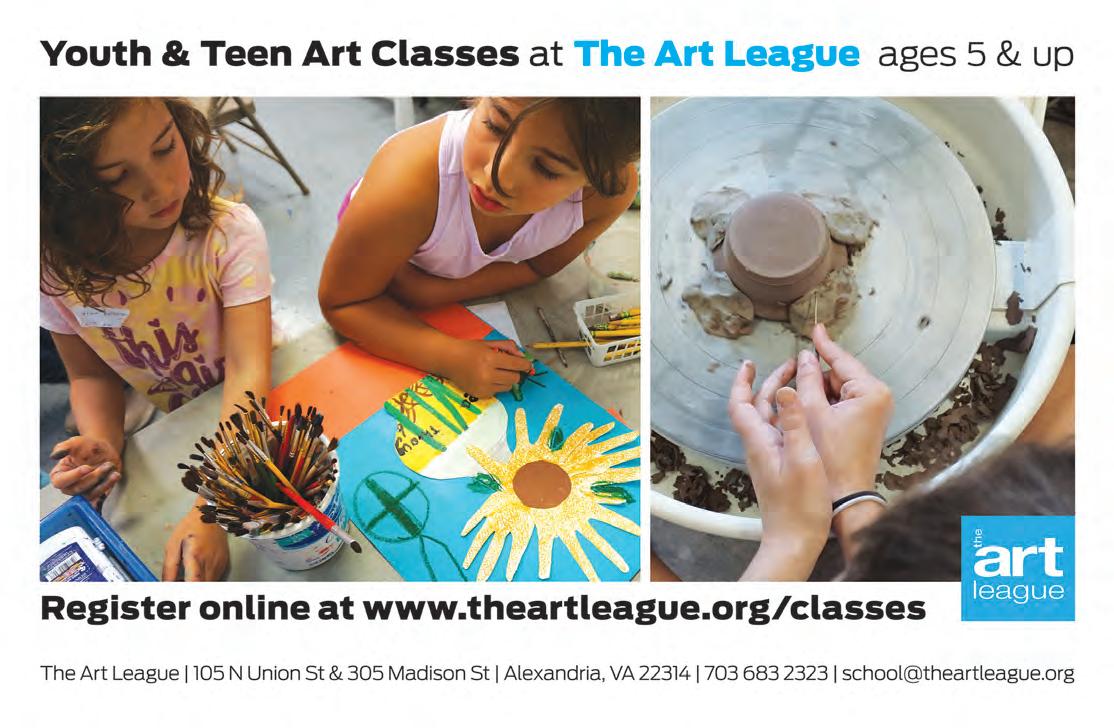

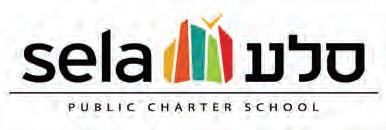
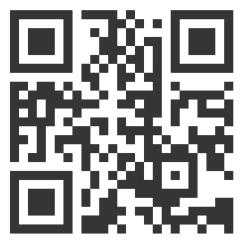





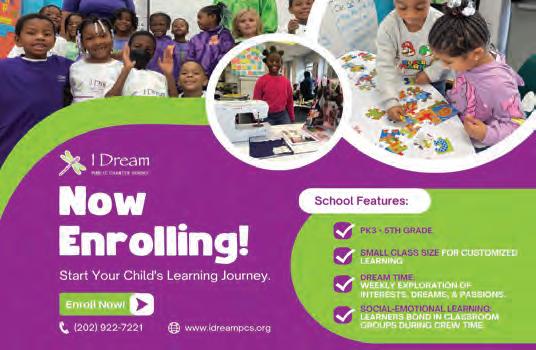
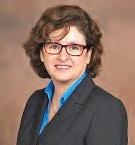
walla, a nancial advisor with e College Finance Coach ( eCollegeFinanceCoach.org). “When is the best time to start planning to pay for college? On the way home from the hospital [with the baby].” e earlier you start, she said, the more the money can grow.
Her best advice? Parents should plan holistically, considering home ownership and retirement goals together with college for kids. And start as early as possible. But if you’re the parent and your kid is years out of diapers, don’t give up, she adds. “Something saved is better than nothing.”
e DC College Savings Plan (www.dccollegesavings.com) is a 529 plan that can be structured on individualized terms. According to statistics from the Education Data Initiative, at the end of 2023, DC families had $1.224 billion saved for college in 529s; each family averaged about $30,500. e 529 plan comes with tax bene ts (up to $8,000 per couple), so even if kids are close to college aged there are still good reasons to put money in a 529.
Pell Grants - Pell Grants are need-based federal nancial aid. Apply for a Pell through the Free Application for Federal Student Aid (FAFSA), providing information about household income to determine student nancial need. FSA will use the information to determine if a student will qualify for a Pell Grant. e maximum
Federal Pell Grant award is $7,395; unlike a student loan, it does not need to be repaid.
DC TAG - e DC Tuition Assistance Grant (TAG) program provides up to $10,000 to make up the di erence between in-state and outof-state tuition for District residents attending college outside DC. It also allows up to $2,500 per academic year toward tuition at private colleges in the District and private Historically Black Colleges and Universities (HBCUs) nationwide.
Students must apply for DCTAG annually via the DC OneApp (dconeapp.dc.gov), which opens Feb. 3, 2025. Applicants and their parents must have lived in the District for 12 months prior to student admission and earn below $500,000 as a household.
Also look into the District of Columbia College Access Program (DC-CAP, dccap.org). DC-CAP’s scholarship programs, including the DC-CAP Scholarship and University Partnerships Scholarship, work to get students into four-year institutions, providing scholarships of up to $25,000. Eligible students must have graduated from a DC public or charter school, be eligible for DC TAG, and demonstrate both nancial need and leadership skills.
Students can only use DC TAG and DC-CAP bene ts at institutions that are partnered with the programs. For DC TAG, that is a list of more than 300 institution, but you should check the list.
It’s also worth mining all the potential scholarships and grants out there. Scholarships are usually awarded based on merit—academic success, or a special ability or skill. A grant is often linked to nancial need but can come with limiting criteria.
Most schools will o er merit scholarships. Students should put e ort into their studies, targeting a GPA over 3.5 and studying hard for tests like the





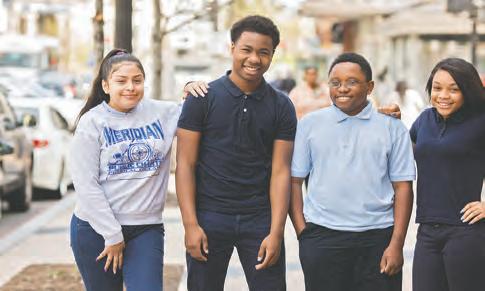
ELEMENTARY
PK3-5th
2021 13th St NW (202) 387-9830
MIDDLE
6th-8th
770 Kenyon St NW (202) 793-2667


• Redefining student achievement and educating the whole child through EL Education
• Visual Arts, Music, Spanish, Performing Arts, Technology Courses
• Sports and extracurricular activities, before and aftercare programming
• Free campus-to-campus shuttle for all students
• 77% of Meridian 8th grade students accepted into Tier 1 or selective D.C. high schools

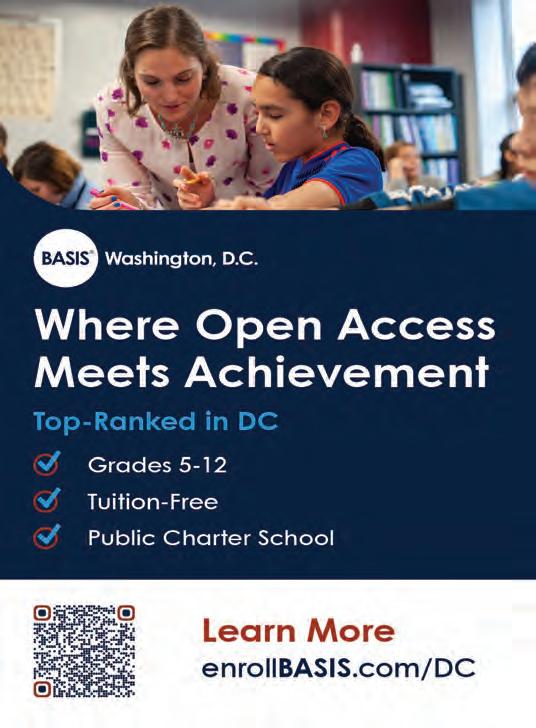













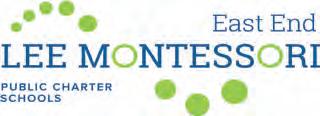
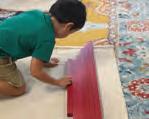

through
Anti-Racist
Graders
Montessori with





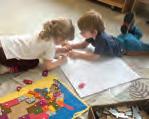
of
and families flourish and
































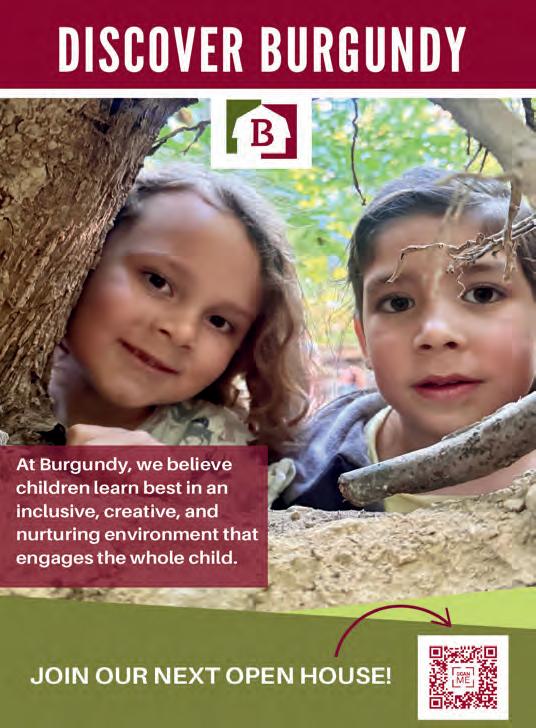
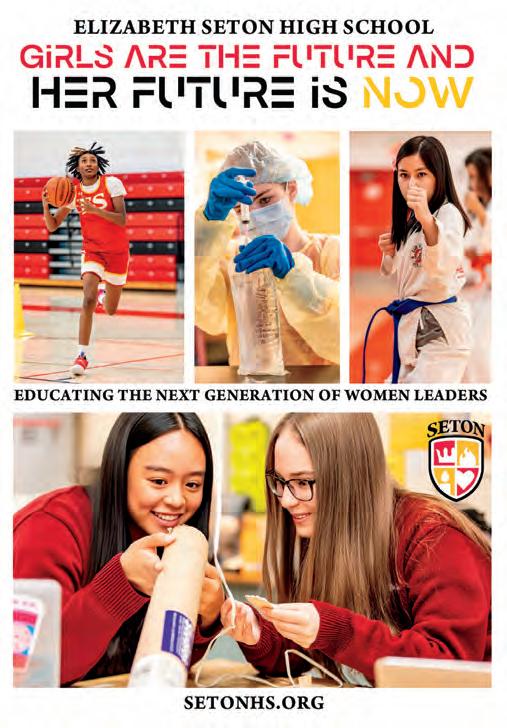
SAT or ACT because many schools automatically calculate scholarship amounts based on GPA.
Next, investigate the myriad sources of independent scholarships out there. Some awards are based on academic accomplishment, others in aspects of personal identity and still others for children of parents in particular professions or who are members of organizations. Parents should check with their employer to see what financial opportunities are offered; students should check with their high school.
There are several search engines that aggregate scholarship offerings, such as Scholarship Owl, Raise Me, and Scholarships.com (you can find eight of them at The College Funding Coach website under “Resources”).
Students should explore their options for scholarships and grants early, to be sure they have a handle on what they would need to do to apply and what the deadlines are.
If you do decide that taking out a student loan is worth it, there are many choices, but some of them should be approached with caution as interest rates are high and penalties for missed payments severe.
Federal Loans (FAFSA) - Students must earn less than $27,000 annually to qualify for a federal student loan. The good thing about direct federal student loans, said Bankwalla, is that they don’t require a credit check, so students can apply directly. They also come with fixed interest rates.
Private Institutional Student Loans - Administered through a bank or financial institution, private loans have variable interest rates depending on the credit rating of the applicant. Because college students rarely have credit ratings—and even more rarely, a good one— parents often co-sign. A good place to start, says Bankwalla, is with Sally Mae (salliemae.com), a former government entity that privatized
and has been offering student loans for years.
Parent Plus Loans - Administered through the US Department of Education, the Direct PLUS, or Parent Plus loan is designed to cover educational expenses that aren’t covered by other forms of aid. They have a higher interest rate than almost any other loan —9.08 percent as of December 2024. There is also a loan fee, 4.228 percent of the loan amount, deducted from disbursements. Both Smith and Bankwalla say these loans should be approached with caution.
“Your kid can always get a loan to go to college, but nobody’s going to give you a loan to retire someday,” Bankwalla said.
A college education is valuable both for the education your child receives and because of the difference it can make to a graduate’s economic future. According to the Social Security Administration (SSA), a bachelor degree increases earning potential over a high school graduate by between $630,000900,000.
But consider all college financing options as early as possible, experts say, to minimize the financial impact on both parents and students. A wellfinanced college education is one way of creating generational wealth.
That’s one of the reasons Lucy, the parent still paying off her own student debt, says she still considers saving for her kids’ education to be important, though it does impact their own home ownership and retirement potential.
“Launching my kids into adult life without debt from school, that seems like one of the best things I can do for them,” she said.
Student loan solution Savi partners with employers to reduce student debt as an employee benefit. Learn more by visiting www.bysavi.com. Make an appointment for college financial planning and see resources at TheCollegeFinanceAdvisor.com u
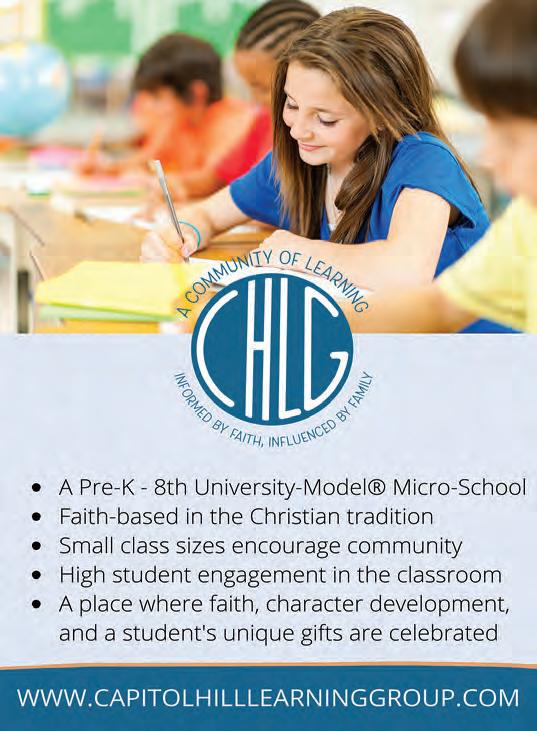
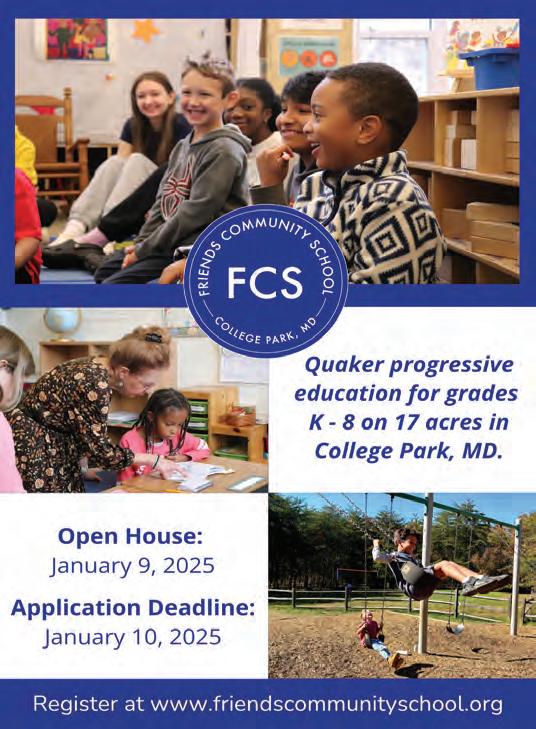





by E.V. Downey



While in the Washington metropolitan area it seems like just about every child attends preschool, the rate is only around 50% attendance for the United States as a whole. Experts have long recognized that the years between the ages of three and ve are critical for learning, that their brains are like a sponge and are primed to be lled with skills and knowledge. us preschool is seen as so bene cial to young children that there is a steady movement among public entities to increase those numbers, starting with the birth of the Head Start program in 1965 and continuing to this day.
Preschool provides so many advantages to children that it is di cult if not impossible to list them all. As school principal Jennifer Geller says, “School is all about routine and regulation. Preschool builds those routines that allow for greater self-regulation and helps kids know how to ‘do school.’” Other bene ts of preschool include:
Most obviously preschool introduces pre-literacy and pre-numeracy skills to three- to ve-year olds. ey learn their letters and at least the concept of phonics if not actually all the letter sounds. ey learn counting and sorting skills as well as shape recognition. Along with these skills they learn more intangible, but equally important academic skills such as problem-solving and critical thinking.

While much of the work is teacher-led in most preschool models, students are still given ample opportunity to make decisions and gure out problems by themselves. American preschools are largely based on centers through which the children rotate. ese centers include activities such as blocks, art, books,
numeracy activities, and pretend play. rough engaging in these activities, and through the social interactions that are a built-in part of this model, preschoolers learn how to plan their time and work in coordination with, if not actually in collaboration with, their classmates. As they get closer to kindergarten age, students are encouraged to participate in group projects in either small or whole class groupings, further preparing them for school and the world beyond.
Most preschools also incorporate art, music, and often dance into their curriculum. Children can experiment with a wide variety of visual arts media that most families don’t have at home. ere is often a music teacher or at least a music time, incorporating instruments with singing. rough exploring the arts of other cultures and through being exposed to students who themselves come from other cultures, preschoolers are exposed to the world beyond their own immediate neighborhoods.
One of the most important aspects of early childhood schooling is the development of social skills. As early childhood music teacher Luisa Cohen says, “Preschool is a vital experience for children. It prepares students for kindergarten with pre-math and pre-writing skills, but the most important lessons they will learn involve social skills. rough dramatic play, negotiating turns with toys and class circle time, children gain invaluable con dence in themselves within a group setting.”
Young students develop skills such as empathy, cooperation, and con ict resolution. ey learn to control their own feelings so that they may better t into a social environment. ey are explicitly taught how to identify their feelings and how to handle them in an appropriate manner.
Young children bene t from the development of healthy attachments outside of their homes and immediate families. Making friends and engaging in trusting interactions with adults helps them develop their own sense of self-worth. Children can be cared for in a safe environment while their parents work or engage in other obligations. ey can learn to foster relationships outside the built-in ones of their home life.
Most parents, especially those with an only child, do not have the experience necessary to identify delays or di erences in their children. Preschool teachers have likely seen hundreds if not thousands of students over the years and have the training and experience to notice if a child is lagging behind his peers. ey
can then ag that child for evaluations so that necessary interventions can be put in place at the earliest possible time.
Preschools also teach children about hygiene such as handwashing. Some preschools incorporate tooth brushing after meals into the day to get students into that habit. Schools also have built in screening programs for hearing and eyesight and some have visiting doctors and dentists as well.
e realities of a modern household, especially in an urban environment, mean that it can be di cult to get children outside and especially to places where they can truly develop their gross motor skills. Preschools build such activities into their daily routine. With obesity at epidemic levels, teaching children the importance of exercise and the enjoyment of gross motor activities is especially important.
Students also typically participate in “circle time” or another similar teacher-led, group activity. is helps young children learn to quiet their bodies and pay attention to an activity led by an adult or to listen to their peers talk. Activities such as the teacher reading aloud not only prompt literacy awareness, but also help develop the ability to quietly pay attention. Activities such as “show and tell,” in which another student talks about an object or experience, additionally helps students recognize when to give their peers their attention.
Receiving an item such as a musical instrument and not getting to choose which one you get is actually an important developmental teaching tool. In the words of the famous Capitol Hill preschool teacher Ms. Frances, “You get what you get and you don’t get upset.” is seems cliche, but it’s actually a vital lesson for young kids to learn. Life is not going to be fair, they are not always going to get what they want, and they have to learn to enjoy themselves regardless.
Ideally, by the end of preschool children are prepared to attend kindergarten, the age at which schooling becomes mandatory. ey have developed the literacy and numeracy skills to handle learning to read and do math. ey have the social skills, emotional tools, and self-control to handle the often quite demanding kindergarten environment.
However, perhaps most importantly, preschool has taught them that the world does not revolve around them. Infants and toddlers are often in “control” of their environments in that they are able to make their needs known (through crying and eventually through language) and those needs are generally met quickly. Most caregivers don’t expect a one-year-old to go hungry simply because it’s not lunch time yet. e infant is fed on demand. In preschool and later in regular school, sometimes a child has to be hungry and yet wait for the appropriate time to eat. Sometimes they want to play outside but it’s reading time. Sometimes they don’t get their preferred center and have to choose a di erent activity. Sometimes a favorite friend doesn’t want to play with them that day.
Preschoolers are learning an invaluable lesson — that there are other agendas in the world and that theirs is not the most important. In fact, sometimes their agenda isn’t even considered or addressed. Yet, they still have to maintain their composure and carry on with their day. is lesson is perhaps the lesson that is most transferable to their later lives as it will bene t them in anything they do.
E.V. Downey is an educational consultant and private tutor. She helps families navigate the lottery, public and private schools, and special needs issues and schools. She also works one-on-one with students who have challenges such as dyslexia, ADHD, and autism as well as those who simply need a little extra help or enrichment on top of their schooling. ◆





by Elizabeth O’Gorek
Henry is reluctant to tell me what he did at camp last summer. That’s because he was a secret agent, tasked with solving mysteries and completing missions for Spy Camp at the International Spy Museum (700 L’Enfant Plaza SW, www.spymuseum.org). But Henry does consent to divulge one bit of information. “I was the best on my team at cracking codes,” he said.
If you attended camp as a kid, you might have memories of canoeing, roasting marshmallows over open fires, archery lessons, crafting and overnights in rustic cabins. Those general camp offerings of mixed activities still exist, but they are becoming eclipsed in popularity by week-long sessions of sailing, gourmet cooking and spycraft as more and more children are spending their summers in specialty camps.
Specialty sessions offer campers the chance to take a deeper dive into their favorite topics. For instance, a general camp experience might include a talent show. But a specialty camp like Rock the Hill (www.rockthehilldc.com) centers all activities around developing a musical performance, from selecting instruments, rehearsing songs, and costuming to stage blocking and sound management. Students spend the week developing the performance they will put on Friday afternoon. With a 4-1 campercounsellor ration, it is still fully student-led, which keeps it fresh. “We might have an instrumental quartet performing a song from a video game, followed by a Metallica song, followed by an original song written about Platypi, followed by a Tom Petty classic,” said co-founder Laura Tsaggaris.

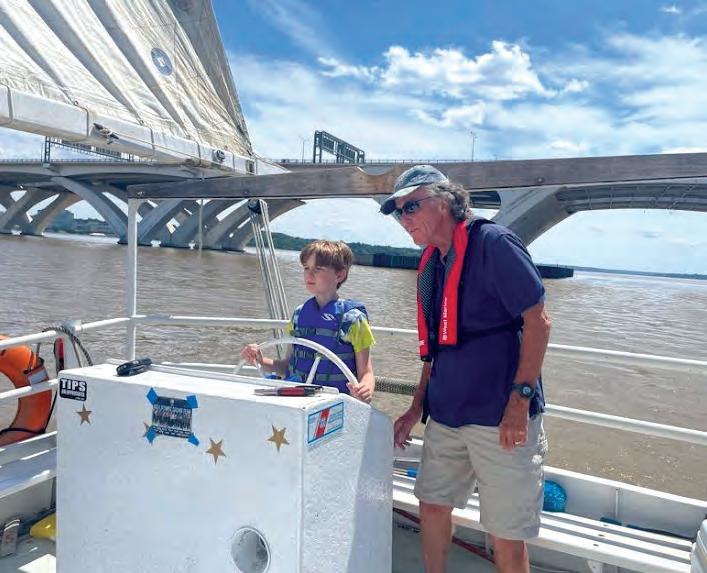
Lauren Kasnett is co-founder of Summer 365, a camp consultant service that helps parents navigate camp choices for their child. She says that because specialty camps are so centered on one topic, often working progressively through the week to a final product or a shared goal, you need to ensure your child is committed to the camp topic. “You really have to have a sustained interest to focus in a specialty camp,” she said.
“If your kid is wanting to bounce around, they might be better suited to a more general camp,” she continues.
Specialty camps in the DMV focus on everything from coding (www. idtech.com), to yoga (breathingspacedc.com) or dinosaurs (www.dinosaurfund.org).
One of the most important considerations in choosing, Kasnett said, is the ability of the program to accommodate your child’s needs and interests. Does your child want to be outside? Are they considering music lessons during the next school year? This is the opportunity to try something on their own terms.
“That’s a benefit of going to a specialty camp,” Kasnett said, “to take a deeper dive and focus on something in a more meaningful way.”
Outdoorsy campers might like to be on the water for some smooth sailing. DC Sail Director of Business Operations Traci Mead oversees the nonprofit’s Kids Set Sail camp (dcsail.org), offered to children ages 7-15. In addition to Kids Set Sail camp, DC Sail is bringing back Schooner Camp (dcsail.org/ schooner-camp).
Under the leadership of a licensed United States Coast Guard Captain

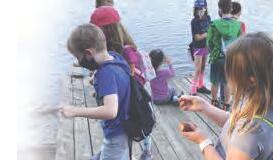
JUNE 30TH - AUGUST 1ST
Children ages 3-10 (PK3-5th Grade)
This summer, let your child unleash their imagination, explore new adventures, and create unforgettable memories!
4 OUTDOOR ADVENTURES: Nature hikes, treasure hunts, and creative challenges.
4 CREATIVE ACTIVITIES: Art, science, theater, dance, and crafts.
4 FUN & FRIENDSHIP: Games, music, and wacky competitions!
SPACES
FLEXIBLE SCHEDULE:
Full Day: 8:0 0 AM – 5:00 PM
Half Day: 8:00 AM – 12:30 PM
Half Day: 12:30 PM – 5:00 PM
2025 SUMMER CAMP FEES
Full Day: $97 per Day $485 per week
Half Day: $67 per Day $335 per week
• Registration Fee: $150 per child (non-refundable)
DISCOUNTS:
• Sibling Discount: 15% off (after the first child)
• DCPS Employee/First Responder/Military Discount: 10%
* SCHOLARSHIPS AVAILABLE FOR FAMILIES EARNING $65,000 OR LESS.
Rate: $280 per child per week
Registration Fee: $100 (non-refundable)


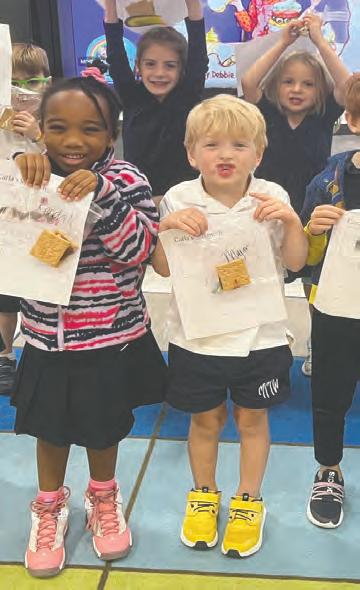







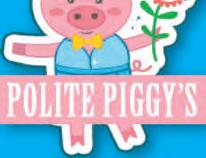


and three skilled crew, campers will have the opportunity to learn how to sail DC Sail’s 65-foot schooner, American Spirit, the only such vessel in the District. The camp was first offered in 2011 but has been unavailable since the pandemic.
Sailing from the pier at Diamond Teague Park (99 Potomac Ave. SE), campers learn seamanship, local history and marine science. They’ll learn piloting, navigating, crew coordination and by the end of the week, Mead said, they will be able to manage the boat.
Mead said comfort on the water is a critical
Specialty camps can be a good opportunity to experiment with different careers. Do you have a kid who loves farming? AgDiscovery, the US Department of Agriculture summer internship program (www.aphis.usda.gov/careers/students-grads/ agdiscovery), is a sort of summer camp for middle and high school students. Participants live on a college campus, expand their view of agriculture and explore careers in agriculture sciences. These include agribusiness, veterinary and botany studies and a combination stream.
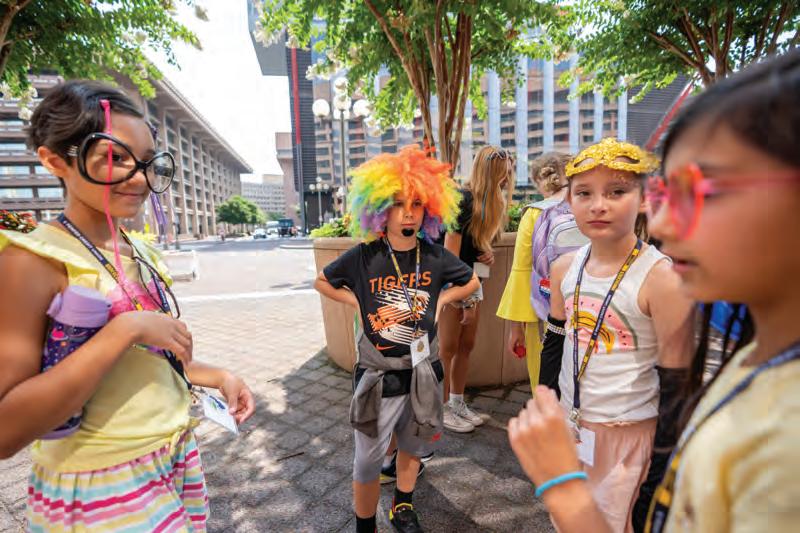
life skill. “For children that live near water, such as those in Washington, DC, with two rivers running through their backyards, so to speak, building an awareness of water and boating safety is very beneficial,” said Mead.
Managing boats is one thing; horses are another. Camp Horizons (camphorizonsva.com) is an equestrian camp for kids aged 8-16. All activities at Horizons, even crafts and games, are centered on horses. Campers spend up to three hours a day riding. But other activities are tailored to help them learn about horses, including stable management, care and grooming and preparation for horse shows.
Or do you have a budding architect? Send them to a session of DACKids (dcarchcenter.org/ programs/youth-programs), the District Architecture Center (DAC) camp, available for kids aged 8 to 10 and 11 to 13. “Like all of DAC’s youth programs, we strive to encourage good stewardship of the built environment,” said Washington Architectural Foundation Youth Programs Manager Heidi Sohng, who oversees the program.
Campers go on field trips to see classical, modern and historic buildings. Experts in the field teach them about drawing, structure, design, measurement and scale and practicing these skills. The one-week session that culminates in the completion of a 3-D model. “We have themes each summer to
inspire the students,” Sohng said. Past themes have included The Future of Living, Superheroes, and Frank Lloyd Wright Inspired Designs.
At the International Museum’s Spy Camp (www.spymuseum.org/education-programs/ youth-family/spy-camp/), where Henry completed his missions, kids get top secret briefings daily, said Aliza Bran, the museum’s director of media relations. Then they head out to a location in the District and put their spy skills and street smarts to the test to fulfill their mission.
Sometimes, campers get to visit a Federal agency. Kids learn about the history of spying through stories of adventure and intrigue. They develop a disguise for cover and practice evasion techniques.
But they also learn how to make and break code and how to create and use gadgets. They explore the science behind spying. “We use the fun and intrigue of spying as a lens for the kids to learn without realizing they’re learning,” Bran said, ”which honestly is the best, most memorable way to learn.”
Kids can also go to camps focused on arts and culture, exploring the world and putting their dreams to the test. For nearly 15 years, Kids and Culture Camp (kidsandculture.com) has helped children learn about and appreciate global traditions. Each week of camp focuses on a different nation, exploring its language, food, music and traditions.
A variety of focused DEAN Adventure camps (summeratpotomac.org/programs/) are on offer at the Potomac School (there’s a bus from Capitol Hill), many focused on art and design. For instance, in Fashion and Machine Sewing, young designers develop creativity and build resilience through the natural cycle of trial, error and improvement as they bring their own fashion designs to life. Designers and tailors work with students to help them develop or modify patterns and then ensure the deigns become a reality. Potomac Schools also offers a musical theater camp, where students bring a musical to life Thursday evening for friends and family and on Friday for their fellow campers. But if your child loves the Bard, kids aged 6 to 11 and 12 to 18 have the opportunity to dive into the world of William Shakespeare with the Shakespeare Theatre Company’s Camp Shakespeare (shakespearetheatre.org). Campers develop acting and stage combat skills as they bring words to life.
Multi-arts Camp Arena Stage (arenastage.org
































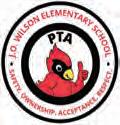

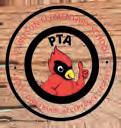


























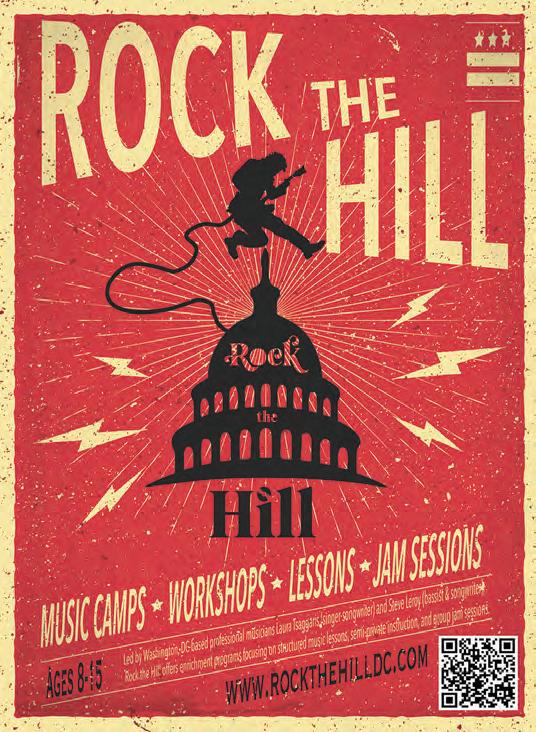
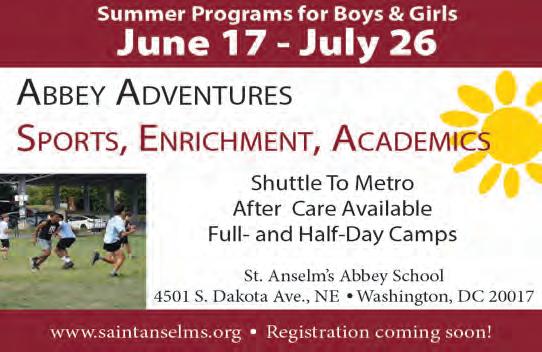
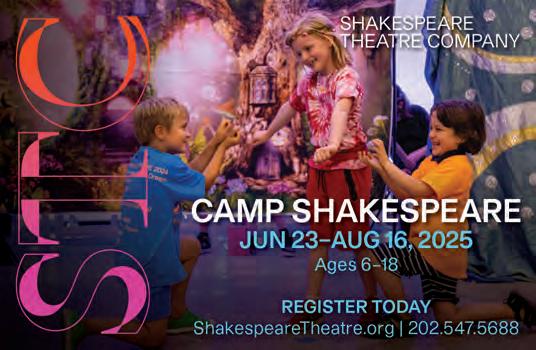
) accepts children aged 8 to 16 years for offerings in theatre, dance, music, visual arts, film-making and writing at the Georgetown Visitation High School campus (1524 35th St. NW). Campers select from a wide variety of classes in multiple art forms. Each child is placed in small groups with a leader that functions as ‘home base’.
Students are encouraged to put themselves out there at Arena Stage, to look for unique and individual responses. “As they explore the arts, young people gain a sense of their own power, and their own value and the realization that they have something to say, that taking a risk and trying something is to be applauded,” said Director of Community Engagement Anita Maynard-Losh.
But camp can also be delicious. Do you have a budding chef? Want to be sure your child can safely handle a knife? Cooking camp is for you.
There are a wide variety of cooking camps available in DC. Culinary Arts Adventure Camp at Sidwell Friends (sidwellsummer.org) gives kids in grades K to 8 a chance to explore the process and meaning behind all their favorite foods. The Hill Center DC plays host to a wide variety of specialty camps in their spacious kitchen (hillcenterdc.org).
But did you know the world’s biggest summer cooking camp is offered in the District? Summer Culinary Camp at Union Kitchen helps kids build confidence, focusing on safety and skill-building as they prepare lunch and dinner.
Kids will feel like they are participating in their own cooking show, plating and photographing their meals while receiving encouragement from the chefs. “You don’t have to be that good to come to our programs. And, you can get that good,” according to a Summer Culinary rep. “Our chefs love it when a student has little experience... they have yet to learn any bad habits!”
Summer Culinary Camp accepts students from 12-17 for their day camp. They also have an overnight camp. Students are supervised 24/7 in the dorms at Gallaudet University, walking 15-minutes to the kitchen. They also get out of the kitchen to explore the city in Rogue Squads, chaperoned small group excursions to monuments, restaurants or for shopping. (summerculinary.com/washington-dc/)
There are so many great specialty camps in the District. Only you can determine what is appropriate for your camper. In addition to their interests, you will want to consider the cost of tuition. But beware of the potential for additional costs for things like transportation and aftercare costs, t-shirts, photographs, supplies, and additional medical insurance where required.
“Understand what your goals are for the camp, location, your budget, the areas of interest in camp programing,” said Kasnett. “But also —and maybe more importantly— consider your child’s personality and interests as well as the way the camp complements your family values.”
Whatever you choose for your child’s summer camp experience, the different experiences and new friendships will be an education that will last a lifetime. “Camp is an opportunity to do things kids are not doing in the school year,” said Kasnett. “Overnight and summer camps in general are one of the greatest classrooms without walls.”
Learn more about Summer365 by visiting their website at summer365. com. Explore summer camp options in one room at the J.O. Wilson Summer Camp Fair, Feb. 1, 2025 at Stuart Hobson Middle School (401 E St. NE), www.dccampfair.com u


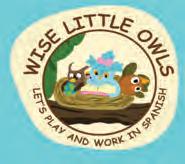
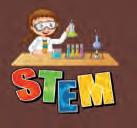
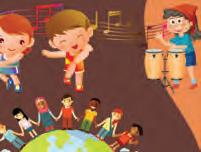
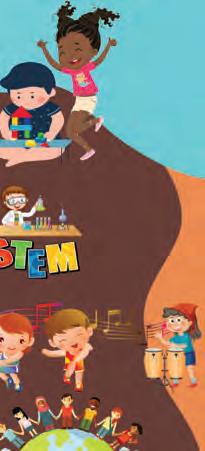


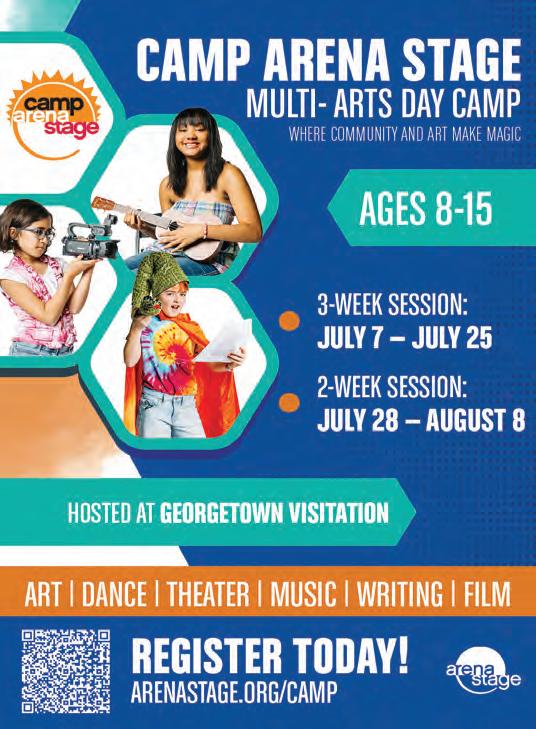
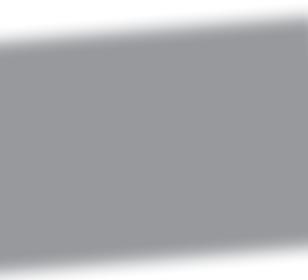
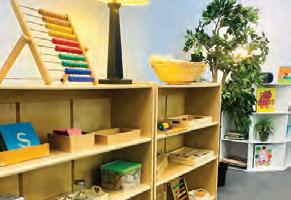






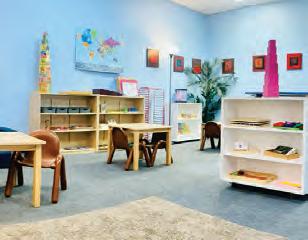





by Kathleen Donner

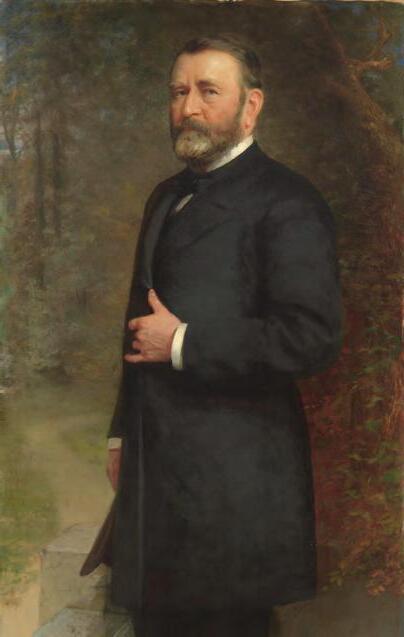

Giant pandas Bao Li and Qing Bao are here—Bao Li, male, born Aug. 4, 2021; and Quin Bao, female, born Sept. 12, 2021. e Zoo’s giant pandas are still acclimating to their new habitat area at the Smithsonian’s National Zoo. Starting Jan. 23, you can visit the new bear pair in their renovated habitat on Asia Trail. e Giant Panda Cam will launch in January 2025 when the bears make their public debut. nationalzoo. si.edu/webcams/panda-cam.
Take the giant panda fan quiz: nationalzoo.si.edu/animals/news/o cialgiant-panda-fan-quiz.
On Saturday, Feb. 15, 11:30 a.m. to 3 p.m., celebrate Presidents’ Day at the National Portrait Gallery’s yearly festival for all ages. Whether you want to learn about US presidents through guided tours of the museum’s “America’s Presidents” exhibition, story times, or art-making and writing activities, there is something for everyone to enjoy. Free but registration encouraged. e National Portrait Gallery is at Eighth and F streets NW. americaspresidents.si.edu.
Ulysses S. Grant was a West Point graduate who had no real ambition to be in the military. He resigned from the Army during peacetime but reenlisted during the Civil War. His unrelenting campaign against Robert E. Lee, in 1864–65, finally won the war for the North.



You know what Dragons really love? Tacos of course. A boy and his dog are watching a TV show about dragons when they unexpectedly get caught up in the Do’s and Don’ts of what to serve to dragons to eat. Dragons love tacos, but if they accidentally eat spicy salsa…watch out! General admission is $25. Dragons Love Tacos is at Adventure eatre, at Glen Echo Park, 7300 MacArthur Blvd., Glen Echo, MD, from Feb. 7 to March 30. adventuretheatre-mtc.org.
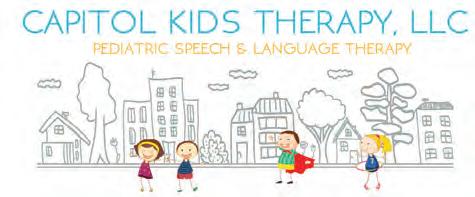

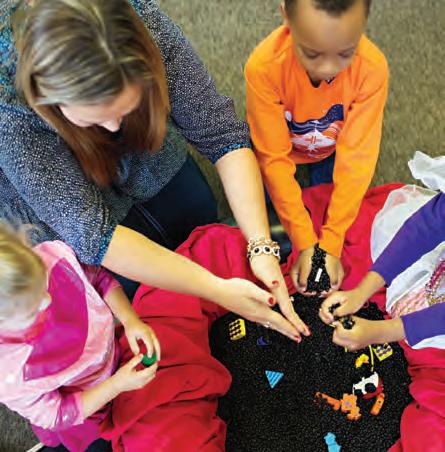


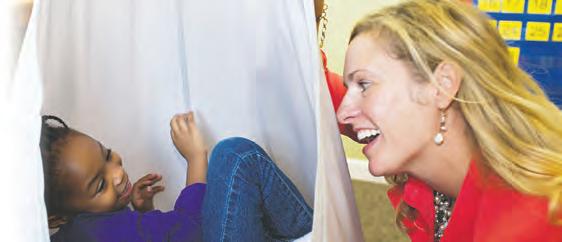
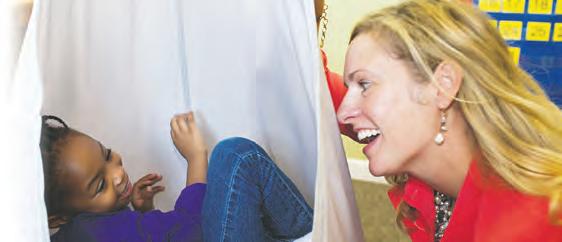

















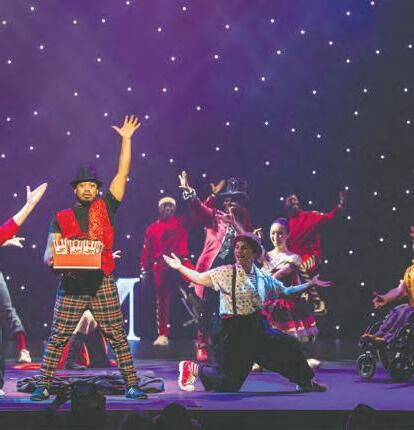
Join J. O. Wilson Elementary, 660 K St. NE, on Saturday, Feb. 1, 10 a.m. to 1 p.m., for its annual Summer Camp Fair. is event brings together the nest camps in DC, Maryland, and Virginia, ranging from traditional camps to academic, arts, music, and special interest camps. Parents and caregivers will have the opportunity to meet camp representatives and learn about the diverse options awaiting your children this coming summer. Free admission. dccampfair.com.
On Mondays, Jan. 20 and Feb. 17, noon to 5 p.m., e Wharf Ice Rink, which is usually closed on Mondays, is open to skaters. e city’s only overwater rink is on Transit Pier outside e Anthem. Adult (12+) admission with skate rental is $25; $19, without skate rental. Twelve and under admission is $20 with skate rental and $15 without. wharfdc.com/wharf-ice-rink.
Omnium Circus is a world renowned comprehensively inclusive and accessible circus company bringing excitement, thrills and joy to people of all ages as only a circus can. Step into a world of all things possible where everyone can discover the power, the passion, and the perseverance of the human spirit. An Omnium Circus performance includes audio description, tactile experiences, integrated ASL assisted listening devices, closed captions (wherever possible), relaxed performances (all forms of self-expression are welcome), calming area in lobby and ADA seating. Omnium means of all and belonging to all–presenting the best in family circus entertainment. Tickets start at $44. Warner eatre, 513 13th St. NW, on Saturday, Feb. 22, 2 p.m. warnertheatredc.com.

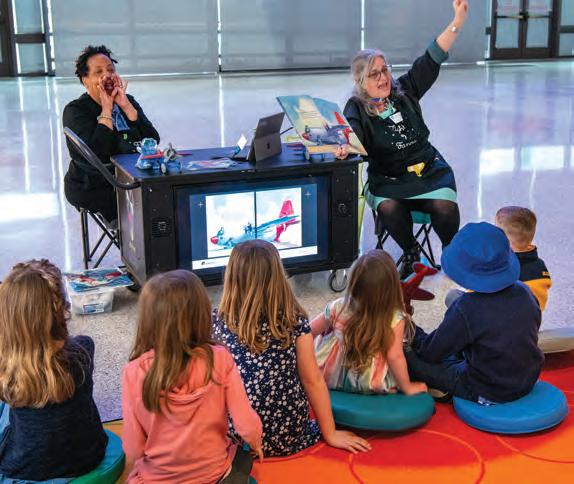
On Feb. 1 and 2, at 11:30 a.m. and 12:30, 2 and 3:30 p.m., both days, hear trickster tales and uncanny stories from Tlingit, Cherokee, Chickasaw, Onondaga, Hawaiian, and Diné story traditions in the Rasmuson eater at the American Indian Museum. Storytellers include award-winning storyteller, visual artist, and stomp dancer Amy Bruton Bluemel (Chickasaw); storyteller Perry Ground (Turtle Clan, Onondaga Nation); traditional storyteller and visual artist Robert Lewis (Cherokee, Navajo, and Apache); and storyteller, musician, trainer and counselor Gene Tagaban (Tlingit, Cherokee, and Filipino). Free. americanindian.si.edu.
From Jan. 17 to 19, dance and theater merge in SHAPESHIFT’s Grey Skies Blue. Grey Skies Blue follows eight friends over the course of a summer, as they share their own stories through captivating movement, exploring themes of social justice, sexual identity, addiction, and betrayal. is inspiring show features endearing characters who resonate with audiences of all ages. Comprised of solo, duet, and ensemble pieces that cover a mix of dance styles, the production’s interconnected vignettes illustrate the uplifting power of friendship when weathering life’s storms. Tickets start at $25. Grey Skys Blue is most enjoyed by the age of nine, up. Following the performance on Saturday, Jan. 18, at 1:30 p.m., young audience members can ask questions and hear stories from the show’s artists and creative team. kennedy-center.org. ◆

On ursdays in January at 11 a.m., join the Smithsonian Air and Space Museum (National Mall Museum) for a reading of Lisa’s Airplane Trip by Anne Gutman and nd out what happens when little Lisa goes on an airplane across the ocean by herself for the rst time. What is it like to cross the ocean in an airplane? Find out about the rst pilots who ever made that trip and draw a picture of your own ocean crossing. Free; timed entry passes to the museum are required. airandspace.si.edu.

My School DC MySchoolDC.org
The My School DC lottery application for public and public charter schools in the District is open for the 2025-26 school year. The deadlines are February 3 for Grades 9-12 and March 3 for PK3 – Grade 8. Have questions or need help? Call the hotline at (202) 888-6336. Apply at MySchoolDC.org.
Office of the Student Advocate studentadvocate.dc.gov
We guide and support students, parents, families, and community members in navigating the public-school system in DC. Our mission is to empower DC residents to achieve equal access to public education through advocacy, outreach, and information services. We provide one-on-one support for families and connect families directly to additional resources as needed. We answer our intake line live on weekdays from 9 a.m. Contact 202-741- 4692 or email studentadvocate.dc.gov
The Art League theartleague.org
The Art League offers hundreds of studio art classes, gallery exhibits, and cultural events in Alexandria, VA. The League fulfills its mission to nurture artists and enrich our community through its gallery, fine art school, art supply store, and outreach programs. Learn more, sign up, or join us at theartleague.org.
Capitol Kids Therapy LLC capitolkidstherapy.com
Founded in 2000 on Capitol Hill, Capitol Kids Therapy provides pediatric speech and language therapy for children up to 12 years of age. Located at 2nd and D St. NE, they offer office-based, home-based, school-based, and daycare-based therapy services. Their therapists specialize in a variety of areas, including (but not limited to) speech therapy, language therapy, feeding therapy, oral motor therapy, and articulation therapy. Services include screenings, parent consultations, parent/teacher workshops, evaluations, and treatment. Capitol Kids Therapy is dedicated to helping your child achieve their full potential.
Early Stages earlystagesdc.org
Early Stages is an evaluation center for children aged 2 years 8 months to 5 years 10 months. ¬ They identify developmental delays and disabilities in children. Early Stages provides evaluations for DC children who are not in school or who are homeschooled. ¬ They evaluate children living outside of DC if they attend a private school or childcare center in DC. Early Stages is a program of DC Public Schools (DCPS). All Early Stages services are FREE.
Total Tutor mytotaltutor.com
At Total Tutor, we use research-backed techniques rooted in cognitive science and neuroscience to help students of all ages, abilities, and learning styles to empower them to become critical thinkers, independent learners, and successful individuals. Our personalized tutoring includes K-12 subject support, test preparation, and college admissions guidance delivered through oneon-one sessions or small-group courses.
AppleTree Schools appletreeinstitute.org
For 20+ years, AppleTree Schools have provided tuitionfree preschool to DC families. With 13 locations, we offer PK3 and PK4 programs blending academics, socialemotional growth, and play. Our experienced teachers foster creativity, engagement, and a love of learning while empowering children to explore their full potential. To learn more, visit appletreeinstitute.org
Capitol Hill Learning Group (CHLG) capitolhilllearninggroup.com
CHLG’s Preschool program, located at 9th & Maryland Ave. NE, is a Christ-centered, parent/teacher cooperative for children ages 2.5 to 5 years. Established in 2006, CHLG is licensed by DC and employs professional teachers, with parents serving as classroom assistants on a rotating basis. The program features hands-on learning, small class sizes, and a tight-knit community.
Northeast Stars Montessori Preschools (NES) www.nestars.net
Northeast Stars Montessori Preschools are fully licensed preschools located in Old Town Alexandria and Capitol Hill, DC. They provide individualized, personal, educational opportunities for the whole child. Teachers deliver “Montessori and More!” through mixed-age (two to five years) classrooms, carefully planned lessons, and the integration of music and arts. NES schools also offer before-care, extended day learning from 3:00 to 6:00 p.m., and flexible part-time spaces.
ToTH Montessori tothmontessori.org
ToTH Montessori is an independent Montessori school located in Capitol Riverfront/Navy Yard. At ToTH we guide young children to reach their full potential by nurturing their curiosity, independence, and enthusiasm for learning. Our trained teachers provide kind and caring guidance in our mixed-age classroom environments for infants, toddlers, and preschoolers. ToTH is a member school of the International Montessori Council and accepts DC Child Care subsidy vouchers.

University for Kids universityforkids.com
With four successful locations around Capitol Hill and 50+ years of combined childcare experience, University for Kids is great choice for your child. The program offers a Bilingual Creative Curriculum, Spanish immersion, certified eco-friendly spaces, balanced meals, and advanced security. They are accepting children aged 6 weeks to 4 years, from 7 a.m. to 6 p.m., Monday through Friday. @ universityforkids
Burgundy Farm Country Day burgundyfarm.org
An inclusive, creative, and nurturing environment, engaging the whole child. Burgundy boasts an expansive, wooded 26-acre Alexandria campus. Outdoor learning spaces, exterior decking on all academic buildings, two outdoor stages, a barn, natural play spaces, and numerous playgrounds expand our students’ learning space. Discover Burgundy today!
Capitol Hill Learning Group (CHLG) K-8 capitolhilllearninggroup.com
CHLG’s K-8 University-Model® program, located at 9th & Maryland Ave. NE offers a Christ-centered micro-school experience. Established in 2006, CHLG features dedicated teachers, small class sizes, and a close partnership between home and school. The program integrates a Christian worldview into all learning, fostering responsible, independent, and self-driven learners.
Elizabeth Seton High School setonhs.org
Rooted in Catholic values and the charism of the Daughters of Charity, Elizabeth Seton High School’s mission is to cultivate confidence in young women to excel in college, careers, and life through an innovative and rigorous academic experience.
Friends Community School friendscommunityschool.org
FCS is a purposeful and joyful school that engages and inspires young children through adolescence. Located just 15 minutes from Capitol Hill on 17 acres in College Park, MD, FCS offers a diverse and inclusive community, a commitment to educating the whole child, and a curriculum emphasizing child-centered and hands-on learning. FCS students are lifelong learners, courageous risk-takers, and joyous peacemakers who matriculate to rigorous independent, parochial, and public magnet schools in the greater Washington, DC, area. See our website for updates and details regarding our open houses and application process.
St. Anselm’s Abbey School saintanselms.org
An independent Catholic Benedictine school for boys in grades 6 - 12. Students benefit from a challenging


academic program, fine and performing arts, and a wide selection of extracurricular activities. Bright and motivated boys are both nurtured and challenged as they grow to become exceptional men.
Washington School for Girls washingtonschoolforgirls.org
The Washington School for Girls (WSG) ignites the joyful pursuit of learning and inspires lives of faith-filled purpose, leadership, and service. WSG is an all-scholarship, independent, Catholic day school educating girls in grades 3-8. Located in Ward 8 and serving the surrounding communities, the school provides an excellent academic program in a supportive environment that engages families and the community in the social, emotional, and spiritual growth of its students and graduates. WSG offers full scholarships to all admitted students.
Bard High School Early College DC bhsec.bard.edu/dc/
Earn a FREE Associate’s degree alongside your high school diploma! Bard High School Early College DC offers a unique early college program that features accelerated 9th and 10th grade classes and Bard College classes beginning in 11th grade. For more information on how to jumpstart your college career visit: bhsec.bard.edu/ dc/admission/
BASIS Washington, D.C.™ enrollBASIS.com/washington-dc
BASIS Washington, D.C. is proud to be the highestranked open-enrollment high school in the District of Columbia, as recognized by the 2024 U.S. News & World Report rankings. In 2021, the U.S. Department of Education honored BASIS DC as a National Blue Ribbon School. Through the acclaimed BASIS Charter School Curriculum, students in grades 5–12 master complex and challenging material across all disciplines. We offer a wide variety of Advanced Placement (AP) courses and post-AP capstone courses, providing a strong foundation for success in college and beyond.
Breakthrough Montessori PCS breakthroughmontessori.org
At Breakthrough Montessori, we believe in providing diverse families in Washington, DC a public Montessori education designed to enable children to develop within themselves the power to shape their lives and the world around them. We are now enrolling students in PK3-6th grade.
Bridges PCS bridgespcs.org
Bridges Public Charter School opened in 2005 and serves a culturally and linguistically diverse student population in Pre-K3 through 5th grade. The school’s developmentally appropriate, student- and family-centered approach includes small classroom sizes, well-trained staff, and

CAPITAL COMMUNITY NEWS, INC.
individual student planning. Bridges PCS incorporates hands-on learning into classroom instruction across grades. The school’s specials include art, music, physical education, and gardening.
Creative Minds International Public Charter School creativemindspcs.org
Creative Minds International Public Charter School fosters exceptional learning experiences that empower pre-kindergarten through 8th-grade students to create a positive impact. Our educational approach combines hands-on, engaging opportunities that bring real-world issues to life with personalized small-group instruction tailored to each student’s unique needs.
DC Prep PCS dcprep.org
DC Prep is a network of public charter schools serving over 2,100 preschoolers through 8th-grade students across six campuses in Wards 5, 7, and 8. The school prepares every child for an academically and socially prosperous future by ensuring more class time, targeted interventions, standards-based instruction, and frequent assessments.
E.L. Haynes Public Charter School elhaynes.org
The award-winning E.L. Haynes Public Charter School serves over 1,100 Pre-K - 12th grade students in Washington, DC. We’re a learning community where every student—of every race, socioeconomic status, home language, and ability—prepares to thrive in college, career, and life. Together, we create a more just and kind world.
Elsie Whitlow Stokes PCS ewstokes.org
The Elsie Whitlow Stokes Community Freedom Public Charter School prepares culturally diverse preschool and elementary school students in D.C. to be leaders, scholars, and responsible global citizens committed to social justice. Stokes teaches children to think, speak, read, write, and learn in two languages: English and French or English and Spanish. We have campuses in the Brookland and Capitol View neighborhoods of Northeast Washington.
Global Citizens PCS globalcitizensschool.org
Washington Global Public Charter School is a 2023 U.S. Department of Education National Blue Ribbon School. Our award-winning middle school program includes project-based learning, small learning communities, technology instruction, arts, and foreign language classes in Spanish and Korean. Our curriculum is designed to create globally competitive students ready for college and careers.
Howard University Middle School of Mathematics and Science hu-ms2.org
Discover Excellence at Howard University Middle School of Mathematics and Science! Empowering future leaders in STEM, we provide an innovative, rigorous curriculum
that blends technology, hands-on learning, and university-level resources. Our scholars thrive in a nurturing environment with small class sizes, cutting-edge labs, and mentorship from Howard University experts. Join us in shaping tomorrow’s innovators today!
Idea Public Charter School ideapcs.org
IDEA prepares scholars with academic, social, leadership, and occupational skills for postsecondary opportunities. Our students choose pathways from five Career Academies: Child Development, Construction, Computer Science, Culinary Arts, and Hospitality & Tourism. Students also have access to work-based learning opportunities, including paid apprenticeships.
I Dream PCS idreampcs.org
I Dream PCS co-designs purposeful, self-directed learning with children and families so they have a voice and choice on the path to discovering and pursuing their dreams. The school offers multi-grade classrooms in PK3-5.
Lee Montessori PCS leemontessori.org
Our East End campus in the Fairlawn neighborhood serves students in PK3 - 4th grade and will grow to serve 6th graders in three more years. We integrate traditional Montessori education with an explicit focus on anti-racism, combined with a supportive foundation of positive discipline and restorative justice practices. This means each one of our students can flourish and show up authentically as their true selves. When they go out into the world, we know they will embody our core values of grace, bravery, growth, joy, and equity because of what—and how—they learned at Lee Montessori.
Mary McLeod Bethune Day Academy Public Charter School mmbethune.org
Mary McLeod Bethune Day Academy PCS is an IB World School dedicated to meeting all students’ educational needs and fostering academic, talent, and personal development. It offers a dual language immersion program for pre-K through 5th grade. The program provides opportunities for each child to develop emotionally, physically, socially, and intellectually at his/her developmental level. We value each child as an individual capable of great talent and learning.
Meridian PCS mpcs-dc.org
Meridian is a nurturing and rigorous school serving PK8th grade students at all academic and developmental levels. Our collaborative, child-centric school community celebrates student diversity and teaches foundational skills needed to succeed in an increasingly global world. As an EL Education partner school, Meridian students engage in meaningful, challenging work that helps them grow socially, emotionally, and academically both inside and outside the classroom.
Mundo Verde PCS mundoverdepcs.org
Mundo Verde Bilingual Public Charter School is Washington DC’s first “green” public charter school, spanning two vibrant campuses for PreK-5th grades. We are dedicated to fostering high academic achievement and compassionate global stewardship, inspiring students to solve big problems. Mundo Verde offers an innovative approach to education through a dual language immersion program based on hands-on expeditions with a focus on sustainability. Mundo Verde is an inclusive and diverse tuition-free school.
Paul Public Charter School paulcharter.org
Paul Public Charter School (Paul PCS), located in Northwest Washington, DC, provides a college preparatory program for grades 6-12, focusing on global awareness and engagement. Paul’s mission is to educate and help students grow into responsible citizens, independent thinkers, and leaders.
Richard Wright PCS richardwrightpcs.org
Richard Wright Public Charter School for Journalism and Media Arts provides a strong, academically enriching, and rigorous program while providing hands-on learning of fundamental concepts and skills essential in Journalism, Broadcast Journalism, Film, Graphic Design, Visual Art, and Music Production. In addition, the school’s innovative curriculum elevates the literacy levels of all its students.
Sela Public Charter School
SelaPCS.org
Sela PCS is DC’s only Hebrew Language Immersion school, proudly rated a Tier 1 School by the DC Public Charter School Board and honored with a Blue Ribbon by the US Department of Education. With a diverse student body and staff reflecting the multicultural vibrancy of the nation’s capital, Sela offers an academically rigorous curriculum. Daily Modern Hebrew studies are integrated into the program, fostering high language proficiency and enriching the educational experience.
Social Justice PCS thesocialjusticeschool.org
Serving grades 5–8, The Social Justice School fosters a dynamic community of middle school students, empowering them to become scholar-activists committed to creating a more just and equitable world. Their innovative academic model integrates social justice, social-emotional learning, and character development, ensuring a holistic approach to education. Through expeditionary learning and hands-on design thinking projects, students engage in meaningful, active learning experiences that inspire them to make a difference. The school also offers afterschool programs and is conveniently located just two blocks from the Fort Totten Metro.
Two Rivers PCS
tworiverspcs.org
Founded in 2004 by a group of Capitol Hill parents, Two Rivers Public Charter School is an EL school serving PK3–8th grade students across three campuses in Wards 5 and 6, Northeast DC. As a high-performing network, its mission is to nurture a diverse group of students to become lifelong, active participants in their education, develop a sense of self and community, and become responsible and compassionate members of society.
Washington Global PCS Washingtonglobal.org
Washington Global Public Charter School has been named a 2023 National Blue Ribbon School by the U.S. Department of Education. Our middle school program includes project-based learning, small learning communities, technology instruction, arts, and foreign language classes in Spanish and Korean. Our curriculum is designed to create globally competitive students ready for college and careers.
Adventures on the Hill summercampdc.com
Our DC summer camp offers a hands-on, engaging learning experience for children ages 3 to 10. With a diverse curriculum in STEM, arts, sports, culture, and wellness, campers explore their interests through exciting daily activities and 1–2 weekly field trips. Camp runs June 23 – August 22, 2025, Monday–Friday, 8 a.m.–6 p.m.
Camp Arena Stage arenastage.org/camp
A place to explore, discover, and create! Camp Arena Stage is a multi-art, full-day summer camp for young people ages 8-15, hosted on the beautiful grounds of Georgetown Visitation Preparatory School. With the encouragement and guidance of professional artists and educators, campers learn by doing—expanding their creativity in theater, dance, music, visual art, filmmaking, and writing.
Camp Shakespeare
ShakespeareTheatre.org/Camp-Shakespeare Dive into the world of one of the greatest playwrights in history: William Shakespeare. Working with theatre professionals, campers unlock Shakespeare’s plays with text analysis, transform into characters through voice and movement, wage battles with stage combat, and develop acting skills. Sessions culminate in a performance at the Shakespeare Theatre Company.
DC Camp Fair dccampfair.com
The DC Camp Fair will feature over 30 of the finest camps in the area, including traditional, academic, arts,

music, and special interest camps. Parents and caregivers will have the opportunity to meet camp representatives and explore a wide variety of options for their children this summer. Hosted by the J.O. Wilson Elementary School PTA
Northeast Stars Montessori Preschools (NES) Summer Camp www.nestars.net
Weekly enrollment for ages 2–6, from 7:30 a.m. to 6:00 p.m. Unleash your child’s creativity while they build lifelong skills! Enjoy week-long themed activities exploring 14 STEM-based themes, including science experiments, outdoor exploration, and play. These activities complement the STEM-heavy curriculum taught in our classrooms and outdoor spaces.
Polite Piggy’s Day Camp politepiggys.com
Since 2008, Polite Piggy’s Day Camp has offered safe, engaging programs where kids thrive. With morning, full-day, and five-week options, children enjoy trips, performances, cultural activities, and unique classes like art, STEM, chess, sports, and a hiking club with Aunt Lizzie. Small camper-to-staff ratios, caring team members, and breakfast and snack included make every day special (a few popsicles too!)
Rock The Hill www.rockthehilldc.com
Led by DC-based professional musicians Laura Tsaggaris and Steve Leroy, Rock The Hill offers music programming for all ages. With an emphasis on custom curriculum and FUN, our music enrichment programs feature private & semi-private lessons, group jam sessions, live show production, recording time, backstage field trips, and guest artist seminars.
Wise Little Owls www.wiselittleowls.com
Wise Little Owls offers a Spanish immersion program for children ages 3–6, featuring fun, play-based activities to build language skills. Our approach fosters empathy, diversity, and a global perspective. This year, enjoy two months of engaging activities to practice Spanish while having fun! u





